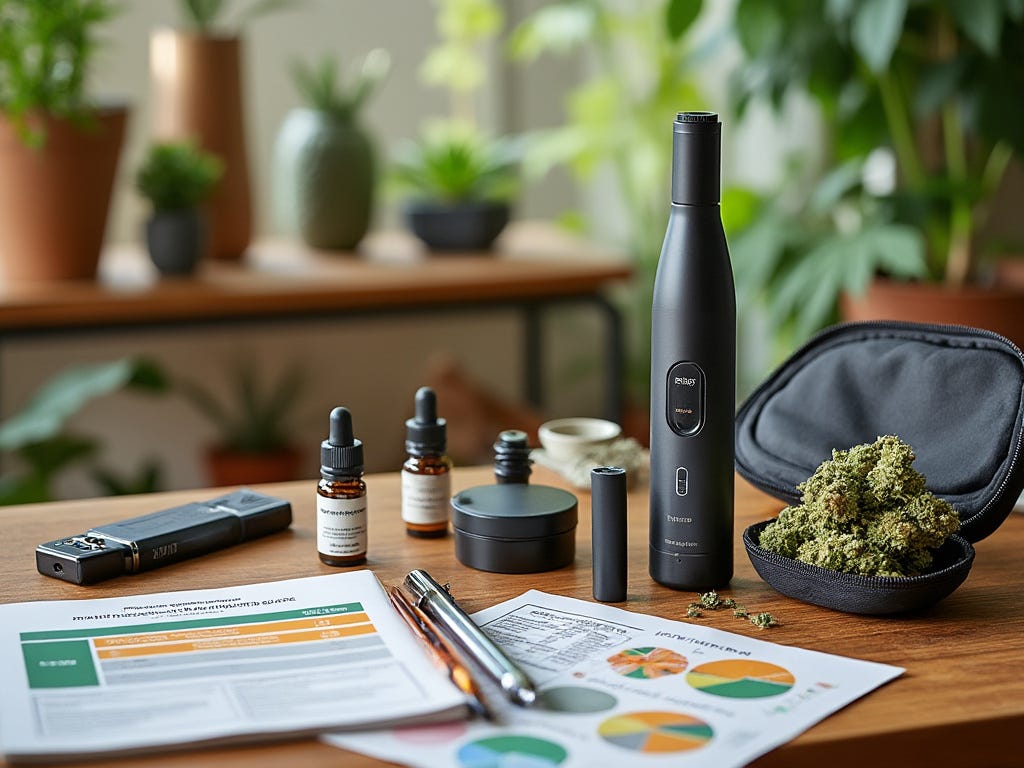Cannabis Tolerance Explained: 4/12 (b)
Smart Strategies and Safety: How to Manage Tolerance for Both Medical and Recreational Use"
This is #4 (b) in a series about managing tolerance to cannabis: Comparing Various Consumption Methods and How They Affect Tolerance.
Contents:
6. The Science Behind Supervised Medical Use: Why It’s Safer
7. Tolerance Tips for Medical Consumers: Your Go-To List
8. Tailoring Strategies for Recreational Users: Managing Tolerance Smartly
9. Practical Applications for Managing Cannabis Use: What Works Best
10. Wrapping It Up: How to Stay Balanced and Enjoy Your Cannabis Experience
To Go Back to part (a) of this section, click here:
Understanding Medical vs. Recreational Cannabis: Key Differences Explained
Therapeutic Use Across All Cannabis Users: How It Benefits Everyone
Managing Health and Tolerance in Medical Cannabis: Practical Strategies
Recreational Cannabis Use: How to Keep the Fun While Managing Tolerance
How Tolerance Differs: Medical vs. Recreational Use Breakdown
6. Evidence from Peer-Reviewed Literature: The Benefits of Supervised Medical Cannabis Use
When it comes to managing tolerance, the research is clear: medical cannabis use, guided by healthcare professionals, tends to result in better outcomes compared to recreational use. In recreational settings, cannabis use often lacks the structure and supervision that can help mitigate the risks associated with tolerance, product inconsistency, and overuse. Here’s a closer look at what the studies reveal:
Psychosis and Cannabis Use Disorder (CUD):
The risks associated with recreational cannabis use, particularly with high-potency products, are well-documented. A study published in *The Lancet Psychiatry* found that daily users of high-potency cannabis were five times more likely to develop psychosis compared to non-users (1). Similarly, research in *JAMA Psychiatry* reported that the prevalence of CUD increased significantly among recreational users, especially with the rising availability of potent THC products (2). In contrast, medical cannabis, when used under the supervision of healthcare providers, typically involves more controlled dosages and lower THC concentrations, which help reduce these risks. The structured environment of medical use prioritizes patient safety and long-term health, offering a protective buffer against some of the dangers seen in unsupervised recreational use.
Health and Safety:
One of the biggest advantages of medical cannabis is the guidance and support from healthcare professionals. A study published in the *Journal of Psychoactive Drugs* showed that patients who used medical cannabis under professional supervision experienced fewer adverse effects and reported better overall management of their conditions compared to recreational users (3). These experts can tailor treatment plans to meet individual needs, regularly monitor your progress, and make necessary adjustments to dosage, frequency, and even the type of cannabis used. This level of personalized care not only helps in managing tolerance effectively but also in minimizing potential adverse effects. By having a healthcare provider in your corner, you’re less likely to fall into patterns of excessive use or misuse, and more likely to achieve the therapeutic outcomes you’re aiming for. This careful balancing act of adjusting environmental factors, compounds, and consumption frequency is what sets medical use apart from recreational use, where these considerations are often overlooked.
Quality and Consistency:
Another significant benefit of medical cannabis is the stringent quality control it undergoes. Research published in the *Journal of the American Medical Association (JAMA)* found that medical cannabis products are generally more consistent in their cannabinoid content compared to recreational products, which often show significant variability in potency (4). This means that when you’re using medical cannabis, you can expect a higher level of consistency in potency and purity—key factors in managing tolerance. Consistent, reliable products help avoid the unexpected side effects that can come from using cannabis with varying or unknown strengths. In recreational markets, the variability in product quality can make it harder to manage tolerance, as you might unknowingly consume stronger or weaker products than intended, leading to a cycle of chasing effects and inadvertently building tolerance faster.
Overall, the evidence suggests that when it comes to managing tolerance and reducing risks, the structured and supervised approach of medical cannabis use offers clear advantages. It’s a system designed with patient safety in mind, providing the oversight and consistency needed to maintain the benefits of cannabis without falling into the traps of overuse and tolerance escalation. Emerging research continues to shed light on the complexities of cannabis tolerance. For instance, studies are exploring how genetic factors might influence individual responses to cannabinoids and how tailored treatment plans could better address varying tolerance levels. These ongoing investigations promise to refine our understanding and management of cannabis tolerance even further, offering hope for more personalized and effective approaches in the future
7. For Medical Consumers: The Tolerance List!
Here is a full list of tried-and-true strategies to help maintain the effectiveness of your medical cannabis regimen while minimizing the impact of tolerance. Each of these approaches offers a way to fine-tune your use, ensuring that you continue to receive the therapeutic benefits of cannabis over the long term:
Consistent Monitoring: Regularly assess how effective your current dosage is, and adjust it as necessary with the guidance of a healthcare provider. This ongoing evaluation helps ensure that your treatment remains effective and that any tolerance development is managed proactively.
Rotating Strains: Using different strains with varying cannabinoid and terpene profiles can help maintain the effectiveness of your treatment. Each strain interacts with the endocannabinoid system differently, so rotating them can prevent your body from becoming too accustomed to a single profile, thereby slowing the development of tolerance.
Adjunct Therapies: Consider incorporating other therapies, such as physical therapy, acupuncture, or counseling, to complement cannabis use. These therapies can enhance overall well-being and may reduce the need for higher cannabis doses by addressing the root causes of your symptoms more holistically.
Breaks: Taking periodic breaks from cannabis, often referred to as “tolerance breaks,” allows your body’s receptors to reset, helping to restore the effectiveness of your usual dose. Even a short break can make a significant difference in reducing tolerance.
Variability in Schedule of Use: Changing the timing and frequency of your cannabis use can prevent your body from getting too accustomed to a routine. For instance, using cannabis at different times of the day or varying the days you consume it can keep your tolerance in check.
Reduced Frequency: Decreasing how often you use cannabis can help slow down tolerance development. For example, if you’re currently using cannabis daily, consider reducing your usage to every other day or only as needed.
Variability in Products (Method): Switching up your method of consumption—whether it’s smoking, vaping, edibles, or tinctures—can impact how your body processes cannabinoids and manage tolerance more effectively.
Variability in Products (Type): Experimenting with different types of cannabis products, such as those with varying ratios of THC to CBD or those rich in specific terpenes, can offer new therapeutic benefits and reduce the likelihood of developing a strong tolerance to any one product.
Variability in Dosage (Amount): Adjusting the dosage of THC and other cannabinoids periodically can help prevent your body from becoming too used to a specific amount. This strategy can also help you find the lowest effective dose, minimizing unnecessary consumption.
Vary Non-Cannabis Physiology: Your overall health—sleep quality, hydration, exercise, and nutrition—plays a significant role in how your body responds to cannabis. Maintaining good health through regular exercise, staying hydrated, and following a balanced diet can support your endocannabinoid system and help manage tolerance.
Caffeine: Some evidence suggests that high volumes of caffeine can affect the metabolism of cannabinoids, potentially flushing them from the body faster. While the relationship between caffeine and cannabis is complex, adjusting your caffeine intake could be a useful tool in managing tolerance.
Vitamin D Flush: High doses of Vitamin D may help recycle cannabinoid receptors, potentially aiding in the management of tolerance. Consult with your healthcare provider to determine if this approach is appropriate for you.
Vitamin C Flush: Similar to Vitamin D, high doses of Vitamin C might assist in recycling cannabinoid receptors, thereby helping to manage tolerance. This strategy could be especially useful for those who are looking to reset their endocannabinoid system.
Basic Nutrition (Filling Gaps and Deficiencies): Addressing nutritional gaps or deficiencies can support overall health and improve how your body processes cannabinoids. Ensuring that you’re getting all the necessary vitamins and minerals can enhance the therapeutic effects of cannabis and help manage tolerance.
Micro-Dosing: Micro-dosing involves taking small, controlled amounts of cannabis to achieve therapeutic effects without overwhelming the system. This approach can help you manage symptoms effectively while reducing the likelihood of developing tolerance.
Vaporize Digitally (Laser-Precision Consumption): Using digital vaporizers that allow for precise temperature control can maximize the efficiency of cannabinoid extraction and reduce the need for higher doses. This method can help you achieve the desired effects while managing tolerance more effectively.
CBD Products: Incorporating CBD into your routine can modulate the effects of THC and help manage tolerance. Since CBD interacts differently with cannabinoid receptors, it can complement THC use by offering therapeutic benefits without contributing to tolerance.
Limonene Products: Limonene, a common terpene found in many cannabis strains, is thought to enhance mood and reduce anxiety. Using products rich in limonene might help reduce the need for high THC doses, thus managing tolerance.
Copious Water: Staying well-hydrated is crucial for overall health and can aid in the detoxification process, potentially helping to manage cannabis tolerance. Drinking plenty of water can also improve how your body processes cannabinoids, ensuring that you get the most out of your treatment.
Download This List
To help you manage cannabis tolerance effectively, I’ve compiled a table that summarizes these strategies, available below the break at the end of the post (accessible to subscribers). Whether you’re using cannabis medically or recreationally, these tools can help you fine-tune your approach and keep your experience enjoyable and effective. (See Table Below)
8. Practical Applications: Tailoring Strategies for Recreational Cannabis Use
For recreational cannabis users, the goal is often to enjoy the relaxing and uplifting effects of THC without letting tolerance dull the experience. By being thoughtful about your consumption habits, you can keep the good times rolling without constantly needing to up your dose.
For Recreational Users
Mindful Consumption: It’s easy to slip into the habit of using cannabis more frequently as tolerance builds, but being aware of how much and how often you consume can make a big difference. Setting personal limits—like deciding how many times a week you’ll use cannabis or how much you’ll consume in one session—can help prevent tolerance from developing too quickly. Being mindful also means understanding why you’re using cannabis. Are you looking to unwind, spark creativity, or just enhance a social gathering? Being clear about your intentions can help you use cannabis more purposefully and avoid overuse.
Tolerance Breaks: Taking regular breaks from cannabis, often called “tolerance breaks,” is a tried-and-true method for resetting your system. These breaks allow your body’s receptors to return to their baseline, so when you do start using cannabis again, you’re more likely to get the effects you’re looking for without needing a higher dose. Whether it’s skipping a weekend or taking a month off, these breaks can make your cannabis experience more rewarding over the long term.
Exploring Alternatives: Variety is key when it comes to managing tolerance. Instead of sticking with the same strain or method of consumption, try mixing things up. Experiment with different strains that have varying levels of THC and CBD, or switch between edibles, tinctures, and vaping. Not only does this keep your experience fresh, but it also prevents your body from becoming too accustomed to one type of product, which can help slow the development of tolerance.
Additional Strategies for Managing Recreational Tolerance
Varying Consumption Methods: Changing up how you consume cannabis—whether you’re switching from smoking to edibles or from vaping to tinctures—can make a big difference in how your body responds. Different methods interact with your system in unique ways, and rotating them can keep your tolerance in check.
Mixing Strains:
Just like with medical use, rotating or blending different cannabis strains can help maintain the effects you enjoy without needing to increase your consumption. Strains with higher CBD content or unique terpene profiles can offer different experiences and help in managing tolerance.
Setting Usage Intentions: Before you light up or take an edible, take a moment to think about why you’re using cannabis. Are you trying to relax, socialize, or get creative? Setting clear intentions can help you use cannabis more thoughtfully, which can prevent you from using more than you need to.
Mindful Environment: Your surroundings can greatly influence your cannabis experience. Consuming in a comfortable, relaxed setting with people you trust can enhance the effects and reduce the temptation to use more. Adjusting your environment—whether it’s dimming the lights, playing your favorite music, or choosing the right company—can help you get the most out of your cannabis without needing a higher dose.
Moderation in Frequency: Even for recreational use, it’s important to moderate how often you use cannabis. Instead of making it a daily habit, try using it on weekends or during special occasions. This approach helps you savor the effects when you do use cannabis and prevents tolerance from building up too quickly.
Combining with Other Activities: Pairing cannabis with activities you already enjoy—like hiking, painting, or socializing—can enhance the experience without the need to increase your dose. By making cannabis a part of a broader experience, you may find that you need less to achieve the desired effect.
Friendly Tips for the Chill Seeker: Medical Guidance for Recreational User
Even if you’re using cannabis recreationally, you can still benefit from medical guidance and counseling. You don’t have to navigate the world of cannabis on your own or feel like the “unwanted stepchild.” Physicians and healthcare providers are here to serve all people, whether you’re using cannabis for medical reasons or simply to unwind. With open arms and an understanding approach, medical professionals can offer advice on how to manage tolerance, choose the right products, and use cannabis in a way that’s safe and enjoyable. Don’t hesitate to reach out for support—your well-being is important, and there’s a wealth of knowledge available to help you make the most of your cannabis experience.
9. Wrapping It Up: Keep the Good Vibes Rolling
Whether you’re using cannabis to ease a chronic pain, wind down after a long day, or just add a little sparkle to your weekend, understanding how tolerance works is the secret sauce to keeping things groovy. By tuning into how your body reacts and mixing up your routine now and then, you can keep reaping the benefits without letting tolerance cramp your style. Whether it’s taking a break, trying out new strains, or simply being mindful of your consumption, these small tweaks can help you stay in the sweet spot. So go ahead, keep the good vibes rolling—just remember to keep an eye on how you’re rolling with it!
And if you’re ever curious about how your state’s laws compare or need personalized advice, don’t forget to check out my chatbot. It’s designed to answer all your cannabis-specific questions, helping you navigate your journey with ease. After all, I’m here to keep the good vibes going strong! This chatbot happens to be educated with the encyclopedia of information that went into The Doctor-Approved Cannabis Handbook, and more!
10. Looking Forward: The Future of Cannabis Research
As the world of cannabis continues to evolve, so too does our understanding of tolerance and how it shapes our experiences. Future research is poised to reveal new insights into the intricate ways cannabis interacts with our bodies, offering fresh strategies to manage tolerance and maximize its benefits. With each new study, we’re getting closer to unlocking the full potential of cannabis—whether through novel consumption methods, personalized approaches, or a deeper understanding of its long-term effects. So, keep your eyes peeled for the latest findings and be ready to adapt as the science progresses. The journey to making cannabis work best for you is far from over, and there’s always something new to discover that can enhance your experience.
Much More On Tolerance… Coming Soon!
Potential Risks and Side Effects of Cannabis Tolerance
Understanding the Long-Term Health Implications
Managing the Risks
Variability in Cannabis Tolerance Among Individuals
Why Some People Develop Tolerance Faster Than Others
Practical Applications
Strategies to Mitigate Cannabis Tolerance
Effective Strategies to Maintain Effectiveness and Manage Dosages
Practical Applications
Detailed Mechanisms of Cannabis Tolerance
How Tolerance Develops and Affects Cannabis Use
Practical Applications
Unique Cases of Cannabis Tolerance
Why Some Individuals Develop Tolerance Differently
Practical Applications
Lifestyle Factors Impacting Cannabis Tolerance
How Diet, Exercise, and Sleep Affect Tolerance
Practical Applications
Combining Cannabis with Other Substances
Understanding Cross-Tolerance and Interaction Effects
Practical Applications
Legal and Regulatory Considerations
How Legalization Affects Consumption Patterns and Tolerance
Practical Applications
Tables & References: Tools to Combat Tolerance
Keep reading with a 7-day free trial
Subscribe to Doctor Approved to keep reading this post and get 7 days of free access to the full post archives.










